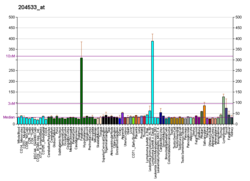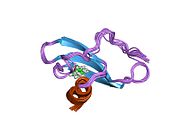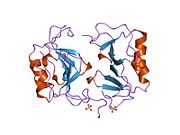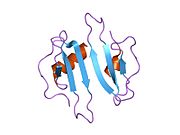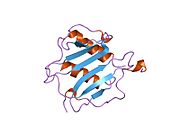CXCL10
C-X-C motif chemokine ligand 10 (CXCL10) also known as Interferon gamma-induced protein 10 (IP-10) or small-inducible cytokine B10 is an 8.7 kDa protein that in humans is encoded by the CXCL10 gene.[5][6] C-X-C motif chemokine 10 is a small cytokine belonging to the CXC chemokine family.
Gene
The gene for CXCL10 is located on human chromosome 4[7] in a cluster among several other CXC chemokines.[8]
Function
CXCL10 is secreted by several cell types in response to IFN-γ. These cell types include monocytes, endothelial cells and fibroblasts.[5] CXCL10 has been attributed to several roles, such as chemoattraction for monocytes/macrophages, T cells, NK cells, and dendritic cells, promotion of T cell adhesion to endothelial cells, antitumor activity, and inhibition of bone marrow colony formation and angiogenesis.[9][10]
This chemokine elicits its effects by binding to the cell surface chemokine receptor CXCR3.[11]
Structure
The three-dimensional crystal structure of this chemokine has been determined under 3 different conditions to a resolution of up to 1.92 Å.[12] The Protein Data Bank accession codes for the structures of CXCL10 are 1lv9, 1o7y, and 1o80.
Biomarkers
CXCL9, CXCL10 and CXCL11 have proven to be valid biomarkers for the development of heart failure and left ventricular dysfunction, suggesting an underlining pathophysiological relation between levels of these chemokines and the development of adverse cardiac remodeling.[13] [14]
Clinical significance
Baseline pre-treatment plasma levels of CXCL10 are elevated in patients chronically infected with hepatitis C virus (HCV) of genotypes 1 or 4 who do not achieve a sustained viral response (SVR) after completion of antiviral therapy.[15][16] CXCL10 in plasma is mirrored by intrahepatic CXCL10 mRNA, and both strikingly predict the first days of elimination of HCV RNA (“first phase decline”) during interferon/ribavirin therapy for all HCV genotypes.[17] This also applies for patients co-infected with HIV, where pre-treatment IP-10 levels below 150 pg/mL are predictive of a favorable response, and may thus be useful in encouraging these otherwise difficult-to-treat patients to initiate therapy.[18] The pathogen Leishmania major utilizes a protease, GP63, that cleaves CXCL10, implicating CXCL10 in host defense mechanisms of certain intracellular pathogens like Leishmania.[19]
References
- ^ a b c GRCh38: Ensembl release 89: ENSG00000169245 – Ensembl, May 2017
- ^ a b c GRCm38: Ensembl release 89: ENSMUSG00000034855 – Ensembl, May 2017
- ^ "Human PubMed Reference:". National Center for Biotechnology Information, U.S. National Library of Medicine.
- ^ "Mouse PubMed Reference:". National Center for Biotechnology Information, U.S. National Library of Medicine.
- ^ a b Luster AD, Unkeless JC, Ravetch JV (1985). "Gamma-interferon transcriptionally regulates an early-response gene containing homology to platelet proteins". Nature. 315 (6021): 672–6. Bibcode:1985Natur.315..672L. doi:10.1038/315672a0. PMID 3925348. S2CID 4358066.
- ^ Luster AD, Jhanwar SC, Chaganti RS, Kersey JH, Ravetch JV (May 1987). "Interferon-inducible gene maps to a chromosomal band associated with a (4;11) translocation in acute leukemia cells". Proceedings of the National Academy of Sciences of the United States of America. 84 (9): 2868–71. Bibcode:1987PNAS...84.2868L. doi:10.1073/pnas.84.9.2868. PMC 304761. PMID 2437586.
- ^ https://www.ncbi.nlm.nih.gov/gene/3627.
{{cite web}}: Missing or empty|title=(help) - ^ O'Donovan N, Galvin M, Morgan JG (1999). "Physical mapping of the CXC chemokine locus on human chromosome 4". Cytogenetics and Cell Genetics. 84 (1–2): 39–42. doi:10.1159/000015209. PMID 10343098. S2CID 8087808.
- ^ Dufour JH, Dziejman M, Liu MT, Leung JH, Lane TE, Luster AD (April 2002). "IFN-gamma-inducible protein 10 (IP-10; CXCL10)-deficient mice reveal a role for IP-10 in effector T cell generation and trafficking". Journal of Immunology. 168 (7): 3195–204. doi:10.4049/jimmunol.168.7.3195. PMID 11907072.
- ^ Angiolillo AL, Sgadari C, Taub DD, Liao F, Farber JM, Maheshwari S, et al. (July 1995). "Human interferon-inducible protein 10 is a potent inhibitor of angiogenesis in vivo". The Journal of Experimental Medicine. 182 (1): 155–62. doi:10.1084/jem.182.1.155. PMC 2192108. PMID 7540647.
- ^ Booth V, Keizer DW, Kamphuis MB, Clark-Lewis I, Sykes BD (August 2002). "The CXCR3 binding chemokine IP-10/CXCL10: structure and receptor interactions". Biochemistry. 41 (33): 10418–25. doi:10.1021/bi026020q. PMID 12173928.
- ^ Swaminathan GJ, Holloway DE, Colvin RA, Campanella GK, Papageorgiou AC, Luster AD, Acharya KR (May 2003). "Crystal structures of oligomeric forms of the IP-10/CXCL10 chemokine". Structure. 11 (5): 521–32. doi:10.1016/S0969-2126(03)00070-4. PMID 12737818.
- ^ Altara R, Gu YM, Struijker-Boudier HA, Thijs L, Staessen JA, Blankesteijn WM (2015). "Left Ventricular Dysfunction and CXCR3 Ligands in Hypertension: From Animal Experiments to a Population-Based Pilot Study". PLOS ONE. 10 (10): e0141394. Bibcode:2015PLoSO..1041394A. doi:10.1371/journal.pone.0141394. PMC 4624781. PMID 26506526.
- ^ Altara R, Manca M, Hessel MH, Gu Y, van Vark LC, Akkerhuis KM, et al. (August 2016). "CXCL10 Is a Circulating Inflammatory Marker in Patients with Advanced Heart Failure: a Pilot Study". Journal of Cardiovascular Translational Research. 9 (4): 302–14. doi:10.1007/s12265-016-9703-3. PMID 27271043. S2CID 41188765.
- ^ Romero AI, Lagging M, Westin J, Dhillon AP, Dustin LB, Pawlotsky JM, et al. (October 2006). "Interferon (IFN)-gamma-inducible protein-10: association with histological results, viral kinetics, and outcome during treatment with pegylated IFN-alpha 2a and ribavirin for chronic hepatitis C virus infection". The Journal of Infectious Diseases. 194 (7): 895–903. doi:10.1086/507307. PMID 16960776.
- ^ Lagging M, Romero AI, Westin J, Norkrans G, Dhillon AP, Pawlotsky JM, et al. (December 2006). "IP-10 predicts viral response and therapeutic outcome in difficult-to-treat patients with HCV genotype 1 infection". Hepatology. 44 (6): 1617–25. doi:10.1002/hep.21407. PMID 17133471. S2CID 27733803.
- ^ Askarieh G, Alsiö A, Pugnale P, Negro F, Ferrari C, Neumann AU, et al. (May 2010). "Systemic and intrahepatic interferon-gamma-inducible protein 10 kDa predicts the first-phase decline in hepatitis C virus RNA and overall viral response to therapy in chronic hepatitis C". Hepatology. 51 (5): 1523–30. doi:10.1002/hep.23509. PMID 20186843. S2CID 205873437.
- ^ Falconer K, Askarieh G, Weis N, Hellstrand K, Alaeus A, Lagging M (December 2010). "IP-10 predicts the first phase decline of HCV RNA and overall viral response to therapy in patients co-infected with chronic hepatitis C virus infection and HIV". Scandinavian Journal of Infectious Diseases. 42 (11–12): 896–901. doi:10.3109/00365548.2010.498019. PMID 20608766. S2CID 28542340.
- ^ Antonia AL, Gibbs KD, Trahair ED, Pittman KJ, Martin AT, Schott BH, et al. (2019). "Pathogen Evasion of Chemokine Response Through Suppression of CXCL10". Frontiers in Cellular and Infection Microbiology. 9: 280. doi:10.3389/fcimb.2019.00280. PMC 6693555. PMID 31440475.
External links
- Human C7 genome location and C7 gene details page in the UCSC Genome Browser.
- Human CXCL10 genome location and CXCL10 gene details page in the UCSC Genome Browser.
- Overview of all the structural information available in the PDB for UniProt: P02778 (C-X-C motif chemokine 10) at the PDBe-KB.
Further reading
- Farber JM (March 1997). "Mig and IP-10: CXC chemokines that target lymphocytes". Journal of Leukocyte Biology. 61 (3): 246–57. doi:10.1002/jlb.61.3.246. PMID 9060447. S2CID 14935171.
- Neville LF, Mathiak G, Bagasra O (September 1997). "The immunobiology of interferon-gamma inducible protein 10 kD (IP-10): a novel, pleiotropic member of the C-X-C chemokine superfamily". Cytokine & Growth Factor Reviews. 8 (3): 207–19. doi:10.1016/S1359-6101(97)00015-4. PMID 9462486.






